Installing a Child Restraint System
Before installing your Child Restraint System, always read and follow the instructions provided by the manufacturer of the Child Restraint System and in this manual to prevent serious injury or death if a collision occurs.
If the vehicle head restraint prevents proper installation of a Child Restraint System, readjust or remove the head restraint for that seating position.
After selecting a proper Child Restraint System for your child and checking that the Child Restraint System fits properly in a rear seating position, there are three general steps for proper installation:
-
Properly secure the Child Restraint System to the vehicle. All Child Restraint Systems must be secured to the vehicle with the a lap/shoulder belt or with a LATCH system in the rear seat of the vehicle.
Make sure the Child Restraint System is firmly secured. After installing a Child Restraint System in the vehicle, push and pull the seat forwards and backwards and from side to side to verify that it is securely attached to the seat. Install a Child Restraint System secured with a seat belt as tightly as possible. Some side-to-side movement can be expected.
-
Secure a child in the Child Restraint System. Make sure the child is properly strapped in the Child Restraint System according to the Child Restraint System manufacturer's instructions.
Check the seating surface and buckles before placing your child in the Child Restraint System to prevent burns. A Child Restraint System in a closed vehicle can become very hot.
The LATCH system connects a Child Restraint System to the vehicle during driving and in a collision. This system is designed to make installation of the Child Restraint System easier and reduce the possibility of improperly installing your Child Restraint System. The LATCH system uses anchors in the vehicle and attachments on the Child Restraint System. The LATCH system eliminates the need to use seat belts to secure the Child Restraint System to the rear seats.
Lower anchors are metal bars built into the vehicle. There are two lower anchors for each LATCH seating position that accommodates a Child Restraint System with lower attachments.
To use the LATCH system in your vehicle, install a Child Restraint System with LATCH attachments.
The Child Restraint System manufacturer provides you with instructions on how to use the Child Restraint System with its attachments for the LATCH anchors.
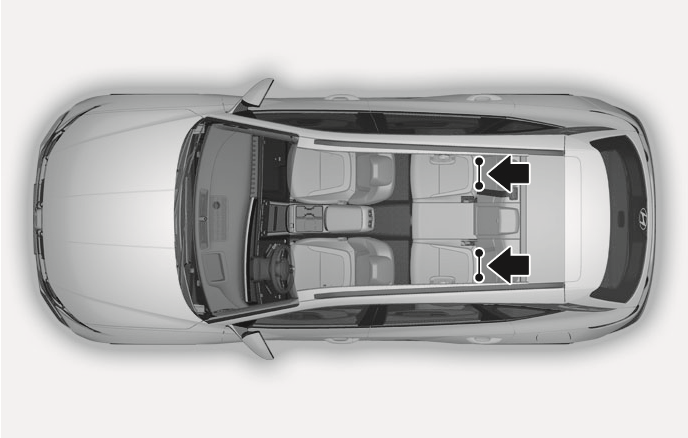
2C_ALRSeatBeltLowerAnchorOverview
LATCH anchors have been provided in the left and right outboard rear seating positions. Their locations are shown in the illustration. There are no LATCH anchors provided for the center rear seating position.
Do not attempt to install a Child Restraint System using LATCH anchors in the rear center seating position. There are no LATCH anchors provided for this seat. Do not use the outboard seat anchors for the center seat. It may damage the anchors that may break or fail in a collision resulting in serious injury or death.

2C_ALRSeatBeltLowerAnchor
- Lower Anchor Position Indicator
- Lower Anchor
The lower anchor position indicator symbols are located on the left and right rear seatbacks to identify the positions of the lower anchors in your vehicle.
The LATCH anchors are located between the seatback and the seat cushion of the rear seat left and right outboard seating positions.
Before installing the Child Restraint System, make sure that there are no objects (e.g. toys, pens, wires) near the lower anchor area. Those objects may damage either the seat belt system or the Child Restraint System during installation. If necessary, have the vehicle inspected by an authorized HYUNDAI dealer.
To install a LATCH-compatible Child Restraint System in either of the rear outboard seating positions:
-
Move the seat belt buckle away from the lower anchors.
-
Move any other objects away from the anchorages that could prevent a secure connection between the Child Restraint System and the lower anchors.
-
Place the Child Restraint System on the vehicle seat, then attach the seat to the lower anchors according to the instructions provided by the Child Restraint System manufacturer.
-
Follow the instructions of the Child Restraint System's manufacturer for proper installation and connection of the lower attachments on the Child Restraint System to the lower anchors.
Take the following precautions when using the LATCH system:
-
Read and follow all installation instructions provided with your Child Restraint System.
-
To prevent the child from reaching and taking hold of unretracted seat belts, buckle all unused rear seat belts and retract the seat belt webbing behind the child. Children can be strangled if a shoulder belt becomes wrapped around their neck and the seat belt tightens.
-
Never attach more than one Child Restraint System to a single anchorage. This could cause the anchor or attachment to come loose or break.
-
Always have the LATCH system inspected by an authorized HYUNDAI dealer after a collision. A collision can damage the LATCH system and may not properly secure the Child Restraint System.
Make sure that the combined weight of the child and the child restraint system is less than 65 lbs. (30 kg) for each LATCH system.
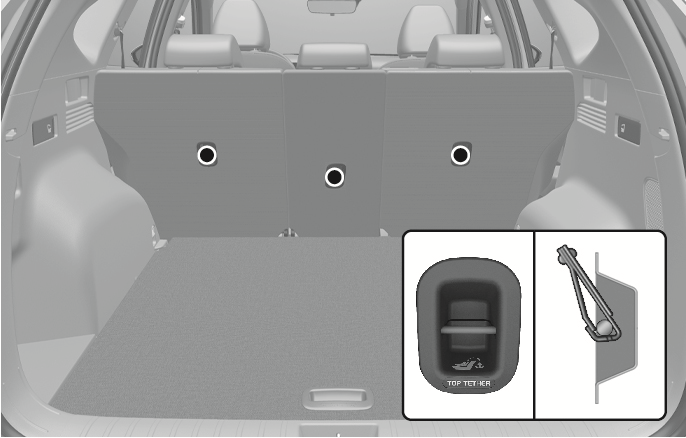
2C_ALRSeatBeltTetherAnchor
First secure the child restraint with the LATCH lower anchors or the seat belt. If the child restraint manufacturer recommends that the top tether strap be attached, attach and tighten the top tether strap to the top tether strap anchor.
Tether anchors are located on the rear of the seatbacks.
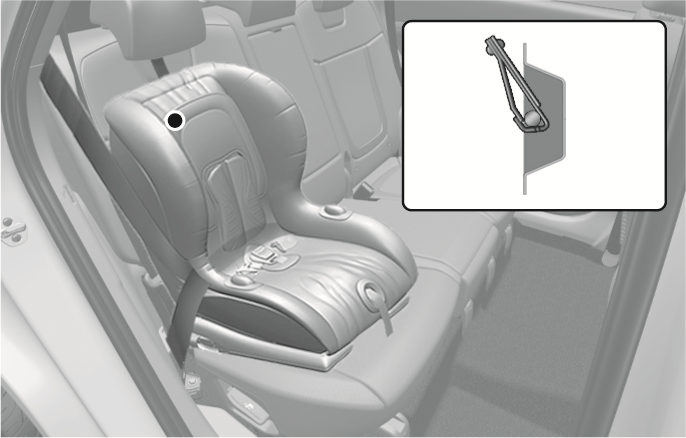
2C_ALRSeatBeltTetherAnchorInstall
To install the tether anchor:
-
Route the Child Restraint System top tether strap over the seatback. Route the tether strap under the head restraint and between the head restraint posts, or route the tether strap over the top of the vehicle seatback. Make sure the strap is not twisted.
-
Connect the tether strap hook to the tether anchor, then tighten the top tether strap according to the instructions of your Child Restraint System's manufacturer to firmly secure the Child Restraint System.
-
Check the Child Restraint System is secure by pushing and pulling the seat forward and back and side-to-side.
Take the following precautions when installing the top tether:
-
Read and follow all installation instructions provided with your Child Restraint System.
-
Never attach more than one Child Restraint System to a single tether anchor. This could cause the anchor or attachment to come loose or break.
-
Only attach the tether strap to the correct tether anchor for that seating position.
-
Make sure that the Child Restraint System anchors withstand the combined weight of the child and the child restraint system of less than 65 lbs. (30 kg) for each LATCH system.
Do not use them for adult seat belts, harnesses, or for attaching other items or equipment to the vehicle.
Always place a rearward-facing Child Restraint System in the rear seat of the vehicle.
Placing a rearward-facing child restraint in the front seat may result in serious injury or death if the Child Restraint System is struck by an inflating airbag.
When not using the LATCH system, all Child Restraint Systems must be secured to a rear seat using the lap/shoulder belt.
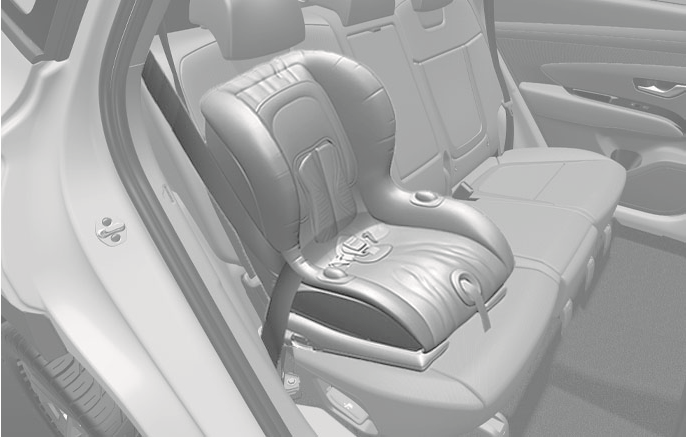
2C_ALRSeatBeltInstall
Automatic locking mode
Since all passenger seat belts move freely under normal conditions and only lock under extreme or emergency conditions (emergency locking mode), you must manually pull the seat belt all the way out to shift the retractor to the Automatic Locking mode to secure a Child Restraint System.
The Automatic Locking mode will help prevent the normal movement of the child in the vehicle from causing the seat belt to loosen and compromise the Child Restraint System.
To install a Child Restraint System on the rear seats:
-
Place the Child Restraint System on a rear seat and route the lap/shoulder belt around or through the Child Restraint System, following the Child Restraint System manufacturer's instructions. Make sure the seat belt webbing is not twisted.
When using the rear center seat belt, refer to the "Passenger and Rear Seat Belts - 3-point system with convertible locking retractor"section in this chapter.
-
Fasten the lap/shoulder belt latch into the buckle. Check a distinct "click" sound is heard.
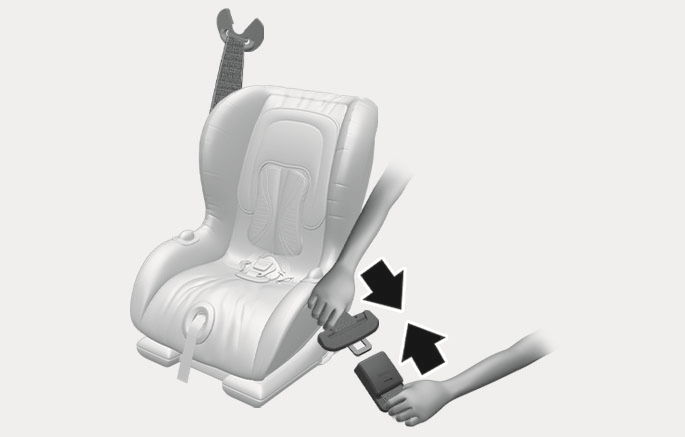
2C_ALRSeatBeltInstall_2
Position the release button so it is easy to access in an emergency.
-
Pull the shoulder portion of the seat belt all the way out. When the shoulder portion of the seat belt is fully extended, it shifts the retractor to the Automatic Locking (child restraint) mode.
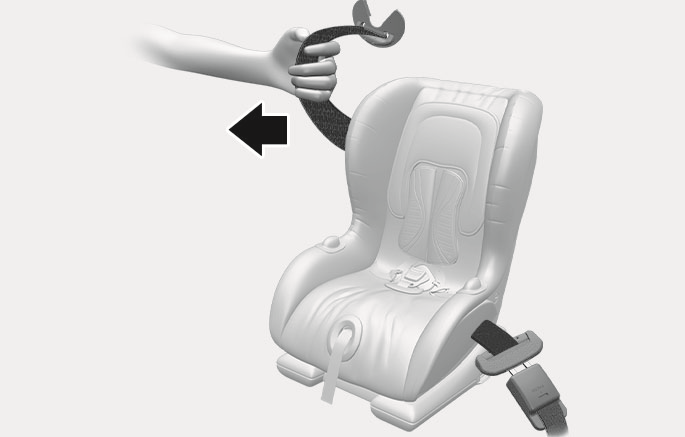
2C_ALRSeatBeltInstall_3
-
Slowly allow the shoulder portion of the seat belt to retract and listen for an audible "clicking" or "ratcheting" sound. This indicates that the retractor is in the Automatic Locking mode. If no distinct sound is heard, repeat Step 3 and 4.
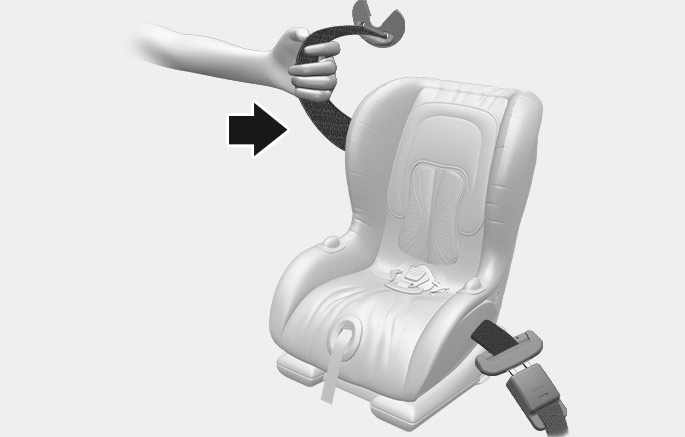
2C_ALRSeatBeltInstall_4
-
Remove as much slack from the belt as possible by pushing down on the Child Restraint System while feeding the shoulder belt back into the retractor.
-
Push and pull on the Child Restraint System to confirm that the seat belt is holding it firmly in place. If it is not, release the seat belt and repeat Step 2 through 6.
-
Double check that the retractor is in the Automatic Locking mode by attempting to pull more of the seat belt out of the retractor. If you cannot, the retractor is in the Automatic Locking mode.
If your Child Restraint System manufacturer instructs or recommends you to use a tether anchor with the lap/ shoulder belt, refer to the previous pages for more information.
When the seat belt is allowed to retract to its fully stowed position, the retractor automatically switches from the Automatic Locking mode to the emergency lock mode for normal adult usage.
Make sure that the retractor is in the Automatic Locking mode. Otherwise, the child restraint may move when your vehicle turns or stops suddenly. A child may be seriously injured or killed if the child restraint is not properly anchored in the vehicle including manually pulling the seat belt all the way out to shift the retractor to the Automatic Locking mode.
To remove the Child Restraint System, press the release button on the buckle and then pull the seat belt out of the Child Restraint System and allow the seat belt to retract fully.